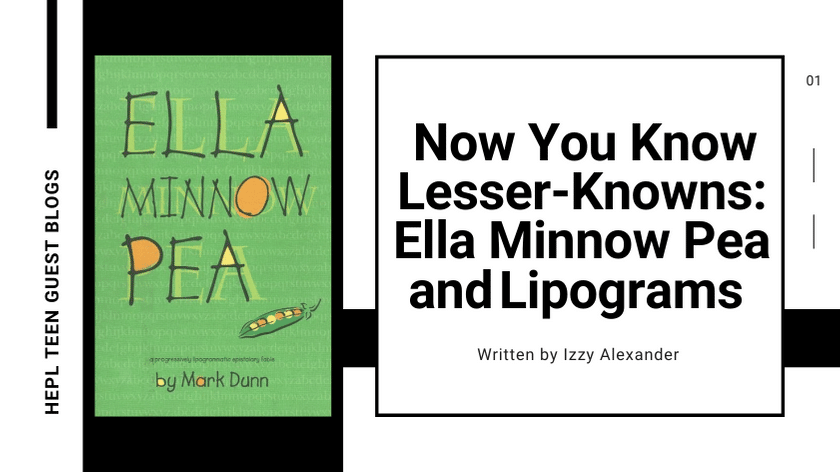 By Izzy Alexander
By Izzy Alexander
This is edition one of five of Now You Know Lesser-Knowns: a blog series in which I (Izzy Alexander) discuss rare literary devices present in teen fiction!
Ella Minnow Pea: A Progressively Lipogrammatic Epistolatory Fable, by Mark Dunn, comes right out and tells you exactly the rare literary device involved in the book. The only problem – lipograms are so unusual that I didn’t even discover their existence until I read the novel.
In Ella Minnow Pea, the main characters live in the birthplace of Nevin Nollop, author of the pangram, “The quick brown fox jumps over the lazy dog.” A plaque on the center of the island displays the phrase, but soon, the letters begin to fall off. The island’s tyrannical council takes this as a sign to stop using these letters. As the novel advances, Ella must make allocations for the dropped letters. At first, she can simply avoid certain phrases, but as time goes on, she must resort to misspelling her transcription of daily events as she fights against the Council’s ban on the dropped letters.
Lipograms are a linguistic challenge/game invented by the Greeks; to play, an author purposefully leaves out one or more letters from a piece of extended prose, like a paragraph, novella, or novel. To date, there are many lipogrammatic pieces published, including a version of The Odyssey omitting one letter of the Greek alphabet per edition of the epic and Gadsby, a lipogrammatic retelling of The Great Gatsby that refuses to utilize a single “E”. Lipograms gained popularity in the late 1960s due to the emergence of a linguistic movement entitled Oulipo – a group of French authors fond of adopting linguistic constraints to their creations, such as palindromes and the Macao constraint (a type of lipogram that only omitted letters containing ascenders and descenders, like b, d, f, or t).
Ella Minnow Pea is an advanced example of a progressive lipogram, since less letters are used as the story advances. You can check it and other lipgrammatic stories at the Hamilton East Public Library.
Lipograms are intriguing because they enable creative play and thinking in the design of literature and prose. Lipograms enable an author to delve into their unique idiosyncrasies and stylistic choices, enhancing both the reader’s and author’s experience amid extremely intentional diction or interesting problem-solving. Authors that force themselves to omit common letters like e, a, l, t, m, and o face unique struggles in finding alternative methods of expressing their sentiment. Lipograms transcend language boundaries, too; lipogrammatic prose has been published in languages like Russian, Japanese, French, and Tamil, among others. In Turkey, there’s a cool lipogrammatic tradition that is essentially improvisational poetry pitting dueling ashiks (or bards) against each other. A pin is placed under the upper lip of each ashik to prevent the lips from touching each other, effectively excluding letters like b, f, m, and v from the improvisational song.
Although some have argued that Ella Minnow Pea’s use of homophones in later chapters – using PH instead of F, or G instead of C – excludes the novel from true lipogram status, it’s still a delightful introduction to lipograms and their rich history. Today, I challenge you to scribe 400 characters of a lipogram and appreciate the extent of difficulty this ancient linguistic game requires! (I myself have just authored this lipogrammatic blog about lipograms excluding the letter “w”, except in the title of the novel mentioned – meaning I couldn’t say common phrases like “within” or “when”, but also some necessary terms in a literary blog like “word” or “writing”!)
Izzy Alexander (she/her) is short (5’3”) and a senior at Fishers High School. She is a fan of all things to do with literature, linguistics, language, and library science, and often daydreams of being a cool librarian once she graduates college. Izzy’s most recently checked out books include the Hildafolk graphic novels by Luke Pearson and Foul Is Fair by Hannah Capin. When she’s not asleep or applying for scholarships, Izzy can be found playing rugby, stage managing, or attempting to memorize the Dewey decimal system.

Meet Izzy
Izzy Alexander (she/her) is short (5’3”) and a senior at Fishers High School. She is a fan of all things to do with literature, linguistics, language, and library science, and often daydreams of being a cool librarian once she graduates college. Izzy’s most recently checked out books include the Hildafolk graphic novels by Luke Pearson and Foul Is Fair by Hannah Capin. When she’s not asleep or applying for scholarships, Izzy can be found playing rugby, stage managing, or attempting to memorize the Dewey decimal system.
